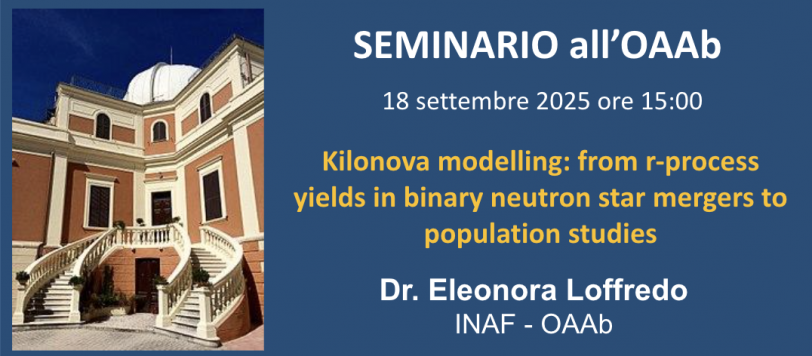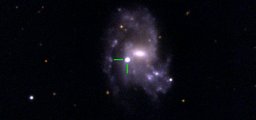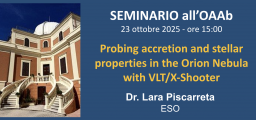Categories: News Seminari
Tags: Evoluzione Stellare Kilonove Nucleosintesi
Posted by: Eleonora Ferroni
Date: Set 12, 2025
Kilonova modelling: from r-process yields in binary neutron star mergers to population studies

Giovedì 18 settembre aprile alle ore 15:00, la Dott.ssa Eleonora Loffredo, dell’INAF-Osservatorio Astronomico d’Abruzzo, terrà il seminario dal titolo “Kilonova modelling: from r-process yields in binary neutron star mergers to population studies”.
Abstract:
Binary neutron star (BNS) mergers eject neutron-rich matter, providing ideal conditions for the nucleosynthesis of heavy elements via the r-process. The radioactive decay of these elements powers a quasi-thermal electromagnetic transient known as kilonova (KN). Despite significant progress since the detection of GW170817, many open questions about KNe remain, such as the interpretation of the spectral features observed in AT2017gfo. Accurate predictions of r-process yields are crucial for modeling and interpreting KN signals, while precise microphysical modeling in BNS merger simulations is essential to determine the properties of the ejecta that seed nucleosynthesis calculations.
Next-generation gravitational-wave interferometers, such as the Einstein Telescope (ET), will dramatically expand the horizon of detectable BNS mergers and improve source parameter estimation, thereby enhancing the chances of detecting electromagnetic counterparts. It is therefore imperative both to improve KN emission models and to provide reliable predictions for the multi-messenger detection prospects of BNS populations.
In this talk, I will address these complementary aspects. I will present nucleosynthesis results from BNS merger ejecta, computed for the first time using tracer particles from numerical relativity simulations with M1 neutrino transport. I will then discuss the prospects for detecting KNe with next-generation multi-messenger observatories, highlighting how uncertainties in neutron star population properties and microphysics affect detection rates, and outlining realistic observational strategies for joint ET–Rubin Observatory operations.






Comments are closed.